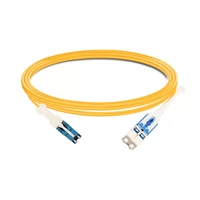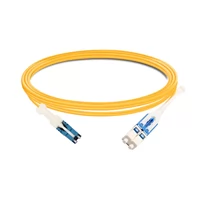Uniboot optical cable is an innovative fiber optic cable that combines two optical fibers to save more space and improve efficiency in data centers or other environments that require high-density fiber optic connections. This article will introduce the characteristics, design and application of Uniboot optical cable in detail.
Table of Contents
ToggleCharacteristics of Uniboot Optical Cable
Uniboot fiber optic cables have several notable features:
High density: Uniboot optical cables are designed with high density. Since it combines two optical fibers, it can provide more connections in the same space.
Simplified management: Uniboot optical cables can combine two connections into one, which simplifies fiber management and reduces the workload of data center operations personnel.
Space-saving: Uniboot fiber optic cables are designed to save space in data centers. This is a huge advantage for data centers with limited space.
Improved efficiency: Uniboot fiber optic cables can increase data center productivity. Due to its design, the number of optical fibers can be reduced, thereby reducing fiber management complexity and workload.
Design of Uniboot Optical Cable
The design of the Uniboot optical cable is very clever. It utilizes a special technology that connects two optical fibers together and packages them in a single bushing. This design makes Uniboot optical cables more compact and efficient than traditional ones.
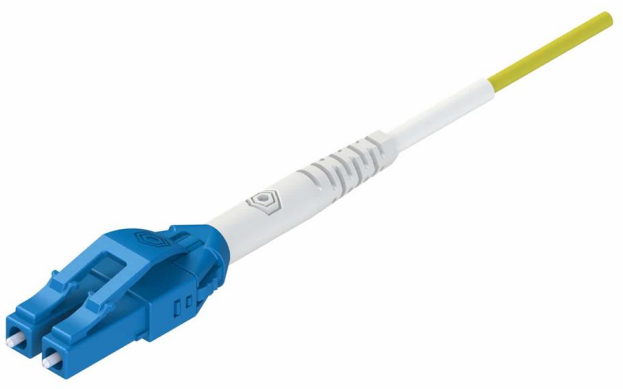
Uniboot Optical Cable
Uniboot optical cable usually consists of two standard optical fibers and a special bush. The two fibers are precisely positioned on both sides of the bush, which ensures their performance while also enabling high-density connections.
Uniboot optical cable consists of the following main parts:
Outer sheath: The outer sheath of the Uniboot optical cable is a durable outer shell used to protect the internal optical fibers and connectors from physical damage and environmental effects. This shell is typically made of high-strength materials to ensure durability.
Fiber core: Uniboot optical cable contains two optical fiber cores, which are the core of optical signal transmission. These fiber cores are available in different types depending on specific application needs, including single mode and multi-mode fibers.
Connector: The two connectors of the Uniboot fiber optic cable are located at both ends of the sheath. These connectors are key interfaces for data transmission, and their quality and performance directly affect the performance of the entire optical network.
Types of Uniboot Fiber
Uniboot fiber optic cables can be divided into two main types by the characteristics and purposes of the fiber:
Single mode Uniboot optical cable
Single mode Uniboot optical cable uses yellow 50/125-micron fiber optic cable, terminated with blue fiber optic connectors. This type of fiber optic cable is suitable for long-distance data transmission, such as fiber optic networks spanning large campuses or cities. It has a smaller fiber core, suitable for high-bandwidth, low-loss applications.
Multimode Uniboot optical cable
Multimode Uniboot optical cable uses aqua 62.5/125 micron fiber optic cable and is terminated with white fiber optic connectors. This type of fiber optic cable is primarily used for short-distance data transmission, such as data centers and corporate intranets. It has a larger fiber optic core, supports high-bandwidth transmission, suitable for high-density cabling environments.
Uniboot Connector Types
Uniboot fiber optic cables can use a variety of connector types, which are selected as needed. Here are some common Uniboot connector types:
LC Uniboot Connector
The LC Uniboot Connector is a square connector with a snap-on design and heat shrink tubing that allows for easy cable connection by simply pressing the clip. LC connectors are commonly used for single-mode and multi-mode fiber optic connections and are particularly suitable for high-density cabling environments.
SC Uniboot Connector
The SC Uniboot connector is a snap-on connector with no clips or heat shrink. There is a protrusion on one side of the connector that makes a click sound when the device is successfully inserted. SC connectors are commonly used for single-mode optical fiber connections and are suitable for various application scenarios.
MDC Uniboot Connector
MDC Uniboot connectors are provided by US Conec. ELiMENT® MDC Connector is a very small form factor (VSFF) duplex fiber optic connector manufactured using 1.25mm ceramic ferrule technology. The push-pull sheath can be easily inserted into or removed from high-density cabling without using special tools. MDC connectors are suitable for applications requiring high-density wiring.
SN Uniboot Connector
SN Uniboot connectors are provided by Senko. It is a very small form factor (VSFF) duplex fiber optic connector manufactured with 1.25mm ceramic ferrule technology. The push-pull sheath can be easily inserted into or removed from high-density cabling without using special tools. SN connectors are suitable for applications requiring high-density wiring and polarity reversal capabilities.
CS™ Uniboot Connector
CS™ Uniboot connectors are also supplied by Senko. It is a very small form factor (VSFF) duplex fiber optic connector manufactured with 1.25mm ceramic ferrule technology. Push-pull tabs can be easily inserted into and removed from high-density cabling without the need for special tools. CS™ connectors offer a high degree of mechanical cyber security and are suitable for applications requiring privacy and security. It prevents inappropriate connections to ensure the security and integrity of the network.
Uniboot Clip Type
Uniboot fiber optic cables also include different types of clips to meet different installation and maintenance needs. Here are some common Uniboot clip types:
Standard clip
The Uniboot optical cable adopts standard cllip design to ensure stable and reliable connection. The cable simplifies fiber optic cabling, minimizing clutter and keeping things tidy. Standard clip Uniboot optical cables usually do not have polarity reversal function, suitable for general optical fiber connection needs.
Flat clip
Flat clip Uniboot fiber optic cables feature a flat clip design with a clip snap on each connector at both ends of the fiber. This flat clip structure can fix the position of the fiber and reduce the risk of fiber damage. Additionally, the flat clip is easy to remove and insert without requiring any tools or exposing the fiber core. Since the direction in which the clip is inserted into the panel determines the polarity of the wire, polarity reversal can be achieved by changing the direction in which the clip is inserted into the fiber.
Clip with push-pull tab
Each connector of this type of Uniboot fiber optic cable is equipped with a pull-tab that is easy to grip and pull. Push-pull tabs can be easily inserted into or removed from high-density cabling without the need for special tools. This design facilitates the insertion and removal of optical fibers, which is especially suitable for applications requiring frequent operations.
Clip with push-pull protective cover
The clip with push-pull protective cover adopts an integrated design of label and protective cover. With a convenient and rugged push-pull sheath, Uniboot fiber can be easily inserted into or removed from high-density cabling without the need for special tools. This design helps protect the fiber from physical damage and increases the cable’s durability.
Safety keyed clip
Senko security keyed clips provide mechanical network security, which is useful in situations where a network needs to be isolated to keep privacy secure. They prevent improper network connections and ensure the security and integrity of the network. These clips can only be removed using a matching color extraction tool, increasing the security of the network.
The Differences between Uniboot and Standard Optical Cable
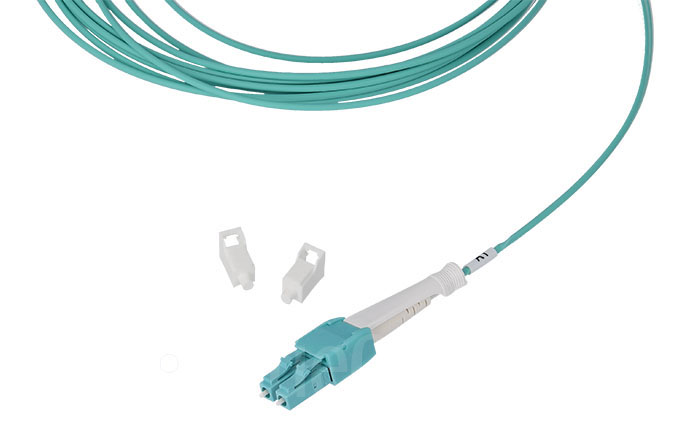
Uniboot Optical Cable
Structure of Conventional Standard Optical Cables
Conventional standard optical cables usually consist of the following main parts:
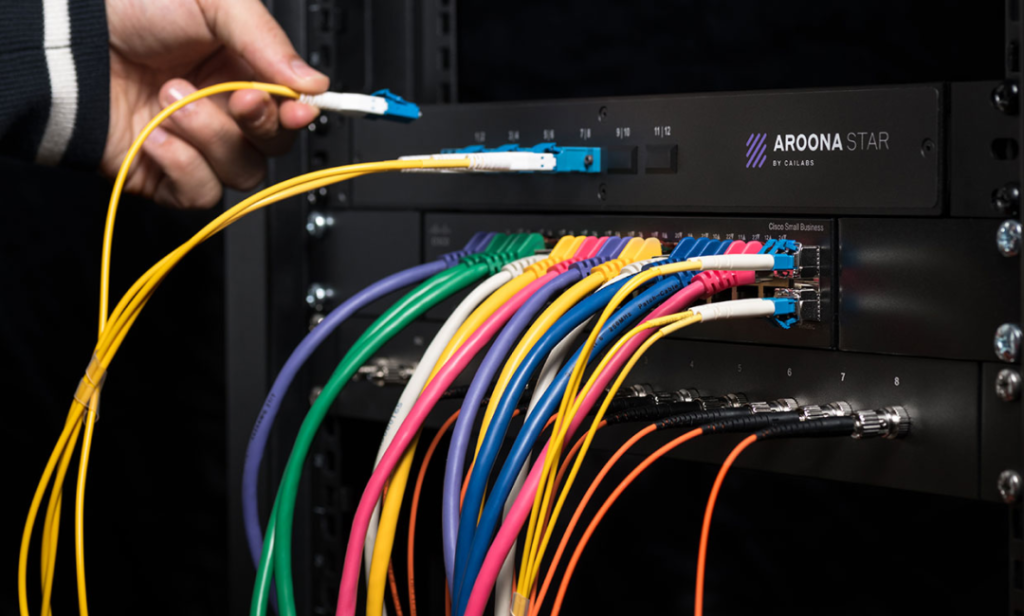
Conventional optical cable
Fiber core: Conventional standard fiber optic cable carries a fiber optic core. This optical fiber core is the core component used to transmit optical signals.
Sheath: The fiber core is usually covered by a sheath that protects the fiber from physical damage and environmental effects. Sheaths can be made from different materials, such as polymers or metals.
Connector: Both ends of conventional standard optical cables are usually connected with optical fiber connectors, which are used to connect the optical cable to optical equipment or other optical cables.
Unique Features of Uniboot Optical Cables
The uniqueness of Uniboot optical cable is mainly reflected in the following aspects:
Dual fiber: The most significant difference is that Uniboot fiber optic cable allows a single fiber optic cable to carry two optical fibers. This feature is useful in high-density cabling environments because it allows multiple optical signals to be transmitted within a limited space without the need for additional fiber optic cables.
Polarity reversal function: Polarity reversal is usually not possible with conventional standard optical cables, but some variants of Uniboot optical cables have this feature. Polarity reversal allows the transmit and receive directions of the fibers at both ends of the cable to be interchanged, which is important for certain applications, such as two-way communications.
Connector design: The connector design of the Uniboot fiber optic cable is carefully formulated to accommodate two optical fibers. These connectors are generally more compact, suitable for high-density cabling environments, and provide reliable connection performance.
Uniboot fiber optic cables are used in a wide range of applications, especially in data centers and enterprise networks. Due to its high density and space-saving characteristics, Uniboot fiber optic cable has become the connection cable of choice in data centers.
In addition, Uniboot optical cables can also be used in various other applications, such as broadband networks, telecommunications networks, urban networks, distance education, medical health, etc. Its applications cover almost all areas requiring high-speed fiber optic connections.
Application Advantages of Uniboot Optical Cable
Enhanced Cable Management
Space saving: The unique design of Uniboot fiber optic cables allows one fiber optic cable to carry two optical fibers, which provides significant space saving advantages compared to traditional duplex fiber optic patch cords. In data centers with high-density cabling, where space is often limited, congestion and clutter of fiber optic cables can lead to performance issues and maintenance difficulties. The space efficiency of Uniboot fiber optic cables allows for more compact cabling, reducing the physical space of fiber optic cables, thereby reducing the risk of cable congestion.
Simplify wiring management: Traditional duplex fiber optic patch cords can become complex in terms of cabling management because each connection requires two separate optical fibers. Uniboot optical cable simplifies cabling management by integrating two optical fibers into one cable, reducing the number of connection points. This simplification makes it easier to identify and track fiber optic cables, helping maintenance personnel quickly identify and resolve problems.
Improve wiring efficiency: The highly integrated design of Uniboot optical cables not only reduces the number of optical cables, but also reduces the complexity of connection points. This significantly improves wiring efficiency and reduces the risk of errors and failures. Data center operators and network administrators can deploy and manage fiber optic cabling faster, improving overall operational efficiency.
Effective Polarity Reversal
For many data center operators and network managers, changing the polarity of standard fiber optic patch cords can be a tedious and time-consuming task, especially in high-density cabling systems. Polarity reversal refers to changing the insertion direction of the optical cable connector to ensure the correct signal transmission direction. Traditional fiber optic cables may require rewiring or tooling to achieve polarity reversal, which often requires significant downtime.
Some Uniboot fiber optic cables offer a polarity reversal option, meaning polarity can be reversed quickly and easily without rewiring or using tools. This feature is very helpful for maintenance and troubleshooting in high-density cabling environments. It can greatly reduce downtime and improve system availability and stability.
Conclusion
Overall, the Uniboot optical cable is an efficient, space-saving fiber optic cable. Its design and features make it an integral part of data centers and other environments that require high-density fiber optic connectivity. Although the design of the Uniboot fiber optic cable may seem simple, its impact is huge. Whether it is improving efficiency or saving space, Uniboot optical cables have demonstrated their strong potential.
In the future, as data centers and cloud computing continue to develop, we can foresee that Uniboot optical cables will be used more widely. For us, understanding the design and characteristics of Uniboot optical cables will help us better leverage this technology to meet our growing network needs.

